There are two major events that occur every year in March. Most of us are familiar with the March Madness basketball tournament. If you teach agriculture in West Virginia you would also associate the month of March with the State FFA Ham, Bacon and Egg Show. This event has been occurring every March since 1941 (with the exception of a couple of war years). I have invited Drs. Harry and Deborah Boone, retired professors from West Virginia University, to educate us about this unique event. So take it away Drs. Boone.
______
Growing up the saying “That is like eating gold” when consuming a high-priced food item was commonly used. Let us share the details of a West Virginia FFA program where the buyer paid a price that approached the price of gold. In 1975, Jerry Hostutler, a student at Hundred High School, sold a ham from his supervised experience program for $11,977 or approximately $31.20 per ounce. In 1975 the price of gold closed at $139.29 per ounce. The buyer of that ham paid approximately 22 percent of the current (1975) value of gold for the ham. To explain how and why the buyer paid this price for Jerry’s ham, let us share the details of a program unique to the West Virginia FFA; the State Ham, Bacon and Egg Show and Sale. To set the stage, let’s review the time period when the program was developed.
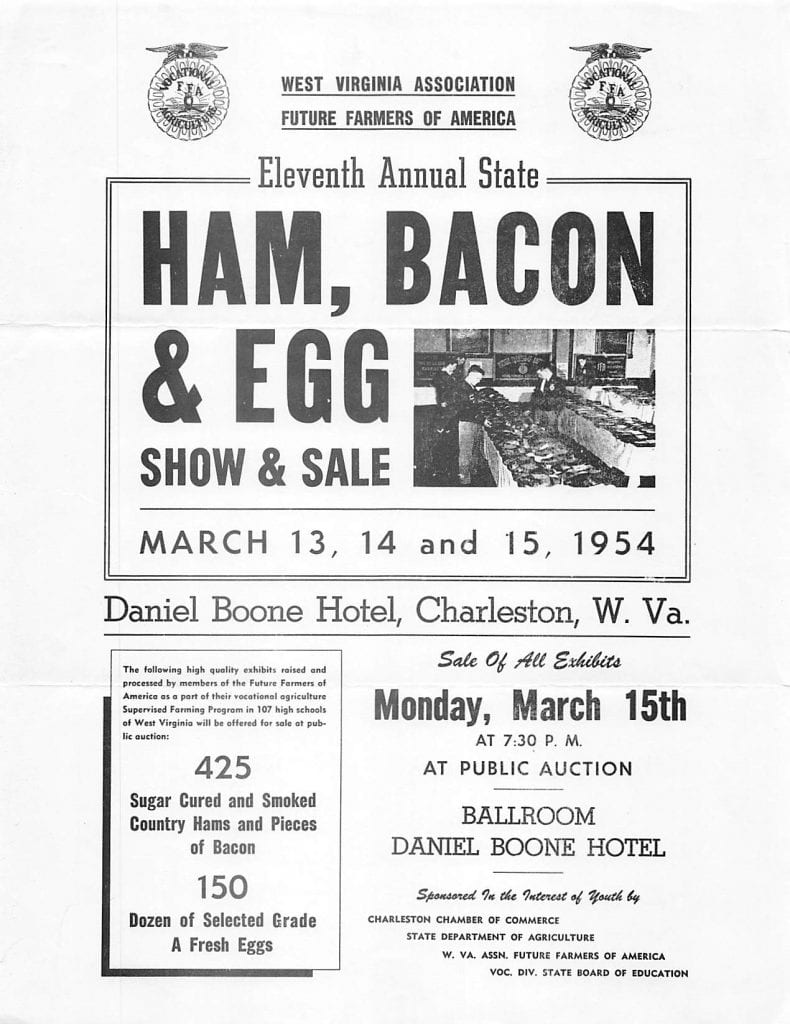
A 1954 advertisement for the Ham, Bacon and Egg Show and Sale.
Note this is the 11th annual event, so we need to go back a few more years to start our educational quest.
The time: the late 1930s. The United States witnessed the stock market crash of 1929. Nearly half of the country’s banks had failed by 1933 and approximately 30 percent of the US workforce was unemployed (History.Com Editors, 2020a). Coupled with the economic problems of the United States, the Midwest and Southern Great Plains experienced severe drought in 1930 followed by dust storms in 1931. The result, an estimated 35 million acres of land was destroyed, and another 125 million acres was rapidly losing its topsoil (History.Com Editors, 2020b). The combination of the depression and drought brought many Americans to the brink of starvation. Soup kitchens sprang up across the United States to assist in meeting the needs of the population.
Even with the “dust bowl,” the Great Depression of the 1930s brought a large “back to the farm” movement. Although there was an increase in the rural population, the percentage was offset by the overall growth in the population. By 1940, the number of individuals living on farms had decreased to less than 1 in 4 of the total population (United States Department of Agriculture, 1943).
In the 1930s West Virginia had approximately 99,000 farms, however, nearly 50% of those farms were under 50 acres (United States Department of Agriculture, 1943). In many sections of the state, the local economy was dependent on the coal industry. Many farmers turned to the mining industry to supplement or replace their farming income. It was estimated that half of the population in some Appalachian areas were eligible for relief under the New Deal standards (Salstrom, 1992).
We have taken considerable time to set up the situation, if not the rationale, for a truly unique program in West Virginia: the West Virginia State FFA Ham, Bacon and Egg Show and Sale. Nationally in the 1930s we had a struggling economy, with a diminished farm production due to the drought and dust storms, soup kitchens, and individuals returning to the farm. How can agricultural education (vocational agriculture[i]) teachers assist in feeding the populations in their communities? One option was through the swine industry. Most farmers could raise a few hogs. The second option was the poultry industry (farm flocks). A flock of chickens, properly maintained, could produce a steady source of eggs while also keeping the family supplied with meat. Both enterprises allow a farm family to make quick and lasting changes to their local supply of meat.
The poultry industry has fewer problems. Eggs can be stored at room temperature for short periods of time until consumed. The bird is harvested on an “as needed” situation. The swine enterprise is a different situation. The rural electrification efforts were just getting underway in the 30s and 40s, therefore freezers/refrigeration were not a reliable solution. Canning (probably hot-water bath) was an option but jars and lids were a luxury that many could not afford. The solution was to “cure” the meat with salt and add brown sugar as a flavoring.
How could these practices be encouraged? One way to encourage the adults is through the youth. Just as corn clubs and corn contests were used in the early 1900s, the West Virginia agricultural education teachers, through the West Virginia FFA Association, developed Ham, Bacon and Egg Shows and Sales to promote the growth of these two enterprises that could feed the community. The process, and the purpose, of the events have evolved over the years, however, the State Show and Sale is still a major event on the WV FFA’s calendar. The notice below illustrates this.
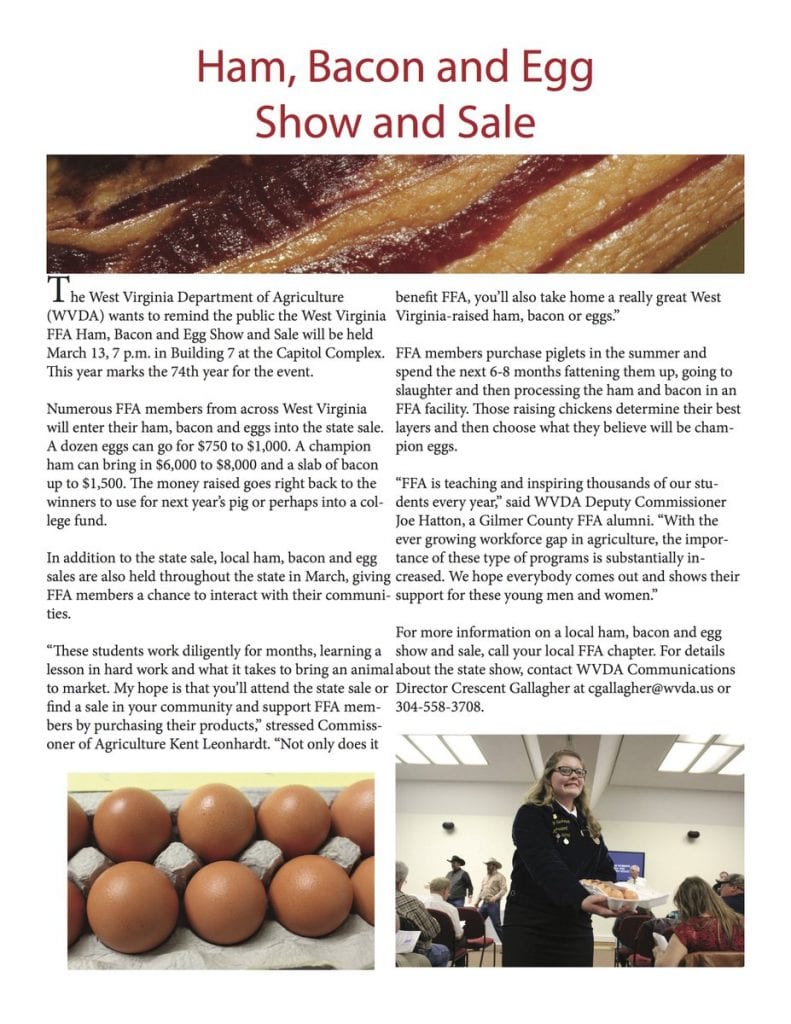
How did the Show and Sale work? Let’s start with the hams and bacons. The student was required to be an FFA member (there was also a show and sale for NFA members) and raise the market hogs as a part of his[ii] supervised agricultural experience (SAE) program. With the advice and assistance of his agricultural education teacher, he would feed the animal to the proper weight, slaughter the animal, perform a rough trim on the hams and bacons, apply a homemade cure of salt, brown sugar, and saltpeter(potassium nitrate), monitor the curing process, remove any extra cure when the curing process is complete, perform final trims, and smoke (usually hickory) the meat. The meat items were judged and sold at a public auction. Because of local program sponsors, the items, especially the winners, brought a premium price. Please note that most, if not all, of this process was completed at the student’s home.
The poultry enterprise was similar. The student was required to be an FFA member and raise the chickens as a part of his supervised agricultural experience (SAE) program. The student would gather a selection of eggs (maybe two or three dozen) usually the day before the judging of the event. With the advice and assistance of his agricultural education teacher he would candle to make certain the eggs were fresh and free from defects. He would select twelve eggs for show that were uniform in size and free from any egg shell defects. A side note: because the eggs are so fresh, they would grade AA. Because of an egg’s quick degradation, the best grade you will buy in a grocery store is a Grade A egg.
In the last quarter of the twentieth century several changes occurred that could have destroyed the ham and bacon portion of the event. Because the products were being sold for public consumption at a public event, they were subject to West Virginia Department of Agriculture regulations for agriculture products sold to the general public. Gradually these regulations were enforced, and changes were made in the program. These changes included:
- All animals must be slaughtered at a state or federally inspected facility.
- All meat will be cured in a state inspected facility
- All meat products must be cured with a commercially approved curing mix that meets federal and state regulations.
- Strict monitoring of moisture content and temperature during the curing process will occur.
- A ham sample accompanied by a summary sheet of curing records must be submitted by each chapter by the WVDA designated date and meet the following criteria to be eligible for the state show:
- A minimum 4% salt content
- A minimum 18% shrink
- A maximum 200 ppm Nitrite
Some of these regulations were easier to meet than others. While slaughtering at a state/federally inspected facility appears to be an easy one, it is not always easy to meet. The standard operating procedure for slaughtering hogs in most commercial facilities is to skin it instead of removing the hair. Some chapters will transport animals three or four hours to an inspected facility that will scald and remove the hair instead of skinning the animal. During the last quarter of the twentieth century, the State Department of Education funded several “meats processing” facilities for West Virginia’s agricultural education programs. With the enhancement in facilities, local programs have the opportunity to teach a wide variety of meats processing skills in addition to the curing of hams and bacons. The commercial curing mix was implemented to make certain that excessive nitrite levels do not exist in the products. The other regulations were accomplished through proper recording of conditions during the curing process.
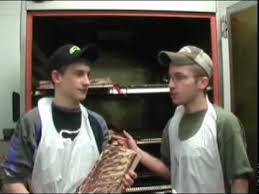
Click on this link to see a 4 1/2 minute video of students at Hampshire High School (WV)
working with their hams and bacon
https://www.youtube.com/watch?v=7dCMDKvs0zA
The following photos are from Ms. Annaliese Henderson, agriculture teacher at Hundred High School in West Virginia.
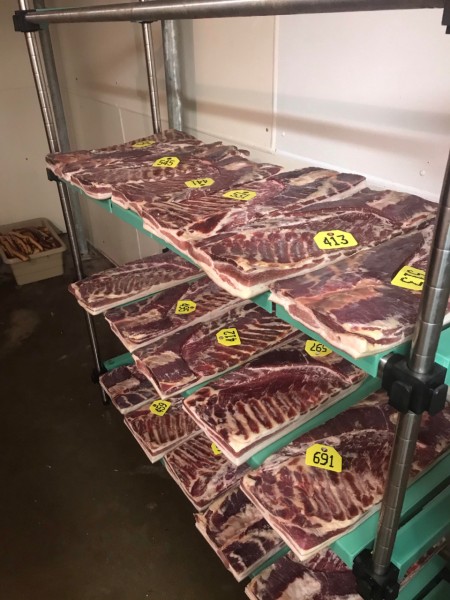
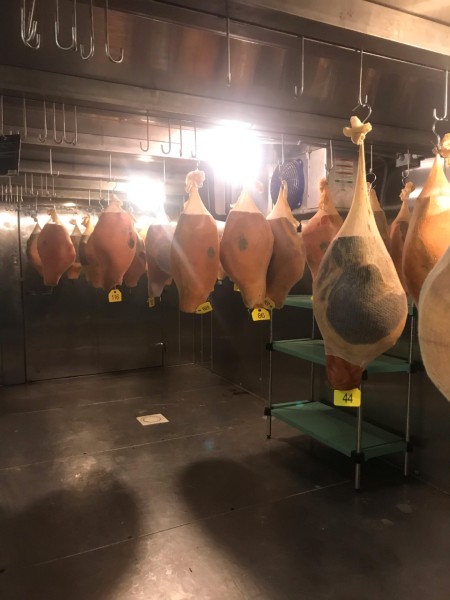

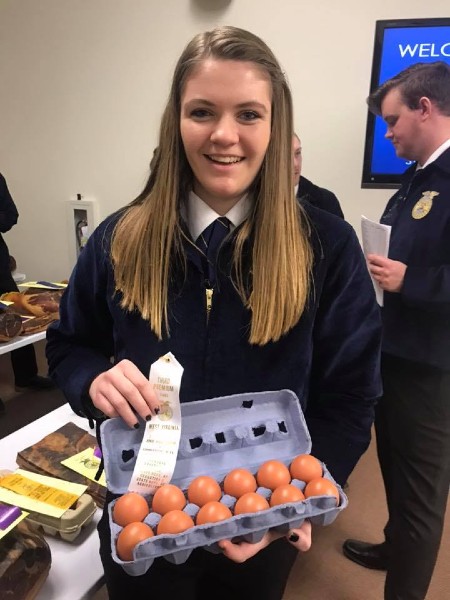
The egg portion of the event has changed little over this time.
In our opinion the focus of the program has changed radically since its inception. The program started to provide a quality and safe food source for the rural communities of West Virginia. It has evolved into a mechanism to prepare students for careers in meats processing. Porter (2014) found that the majority of programs with meats facilities (55.56%) had 3-5 graduates secure employment in the animal processing field over the last five years. For the students that are not pursuing a career in the meats industry, they have become more educated consumers of meat products.
The following is a summary of the West Virginia State FFA Ham, Bacon and Egg Show and Sale’s successes (West Virginia FFA and Agricultural Education, n.d.).
- The first State Future Farmers of America Ham, Bacon and Egg Show and Sale was held in 1941 at the Daniel Boone Hotel, Charleston, WV. Since that date, 40 shows and 38 sales were held at the hotel. During the years 1943 and 1944, a show was held, but no sale. The show and sale were discontinued in 1945-47 due to the war effort.
- The 76 sales to date have netted the FFA members a sum of $1,471,985.78. A total of 7994 hams, 5911 bacons and 4043 dozen eggs have been sold.
- The first sale in 1941 amounted to a total of $204.82. The prize ham sold for $23.63; the prize bacon for $2.75; and the prize dozen eggs for $2.25. The largest sale was held in 1981, with the total sales amounting to $53,624.24.
- The records show that the highest price paid for a champion ham was $11,977.00. The ham was exhibited by Jerry Hostutler of Hundred in 1975.
- The highest price paid for a champion bacon was $6,400.00 in 2007. The bacon was exhibited by Phillip Dennison of Valley High School.
- The top price for the champion eggs (dozen) was $10,000.00 in 2007. The eggs were exhibited by Kim Riley of Cameron High School.
The 2019 champion ham, raised by Austin Craven of Tyler Consolidated High School, weighed in at 22 lbs. and sold for $4,400. The champion bacon belonged to George Brown of Valley High School and was purchased for $1,530. The champion eggs raised by Autumn Radford of Greenbrier East High School sold for $600.
West Virginia Commissioner of Agriculture Kent Leonhardt was on hand for the sale to cheer on the students and stress the importance of the event. “Every penny of this sale goes right back into the pockets of the young men and women of the FFA. They not only learned how to raise an animal, they also processed the meat. Those are valuable lessons. Now they’ll take home money to put towards next year’s animal or their college savings fund,” said the Commissioner (West Virginia Department of Agriculture, 2019, p. 5). Follow this link (https://www.youtube.com/watch?v=m-cyKQ612SU) to see the WV Commission of Agriculture talking about the 2017 Show. The video is two minutes long.
This article has concentrated on the State level shows and sales. There are a number of chapter, county, multi-county events held each year in the state. In most situations, a student may enter one entry in a local sale and one entry in the state show and sale. There are some events, including the one Harry co-organized as a high school agricultural education teacher, that involves 4-H youth. Ham, Bacon and Egg Shows and Sales are a major event when it comes to West Virginia FFA.
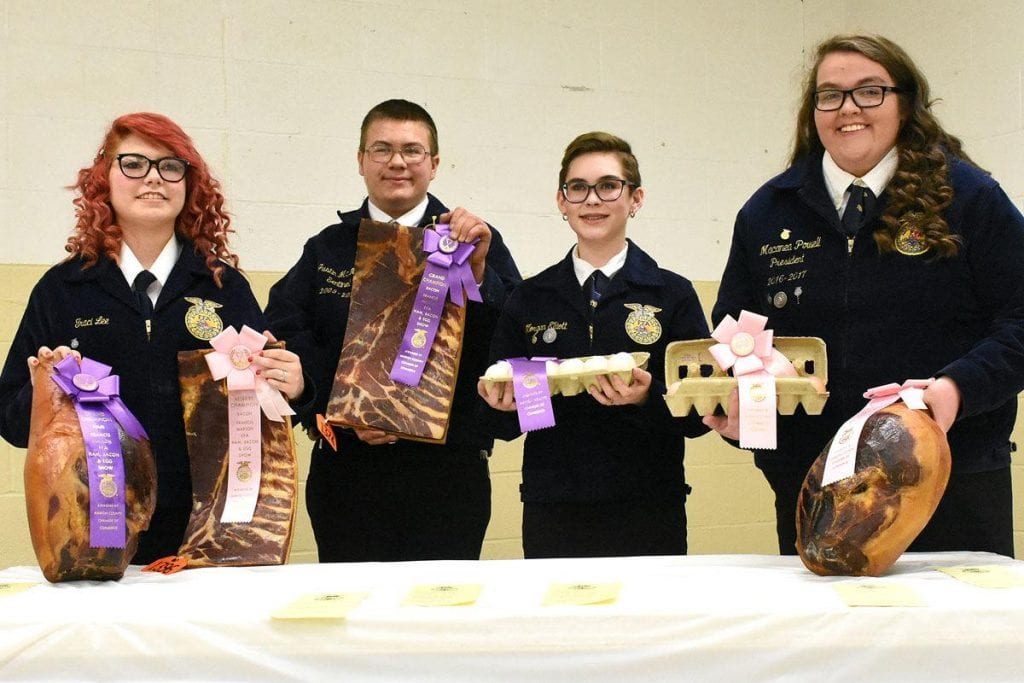
Marion County FFA members with the winning entries in their county Ham, Bacon and Egg Show in 2018. (photo from the Times West Virginian)
If you are interested in purchasing a “country cured” ham or bacon, or a fresh dozen of eggs, plan on attending the 2020 WV State Ham, Bacon and Egg Show and Sale on March 8-9 in Charleston, WV. Contact Lead Coordinator Nathan Taylor for additional information (netaylor@k12.wv.us or call 304-558-2347).
References
History.Com Editors. (2020a). Stock market crash of 1929. A&E Television Networks.
History.Com Editors. (2020b). Dust Bowl. A&E Television Networks.
Porter, E. N. (2014). The current status of meat processing facilities in agricultural education programs in West Virginia. (Thesis). Retrieved from https://researchrepository.wvu.edu/etd/614.
Salstrom, P. (1992). Subsistence-barter-and-borrow systems: An approach to West Virginia’s economic history. West Virginia History, 51, 45-54.
United States Department of Agriculture (1943). Farms and farm property. Sixteenth Census of the United States: 1940 Agriculture. Washington, DC: United States Printing Office.
Wayman, W. H. (1978). History of the West Virginia Association Future Farmers of America: 1928-1978. Charleston, WV: West Virginia Association Future Farmers of America.
West Virginia Department of Agriculture. (2019, April). 76th annual ham, bacon and egg show. The market bulletin, 103(4), 5.
West Virginia FFA and Agricultural Education). (n.d.). Brief history State FFA Ham, Bacon and Egg Show and Sale. Retrieved from http://www.wvffa.net/BRIEF_HISTORY_HBE_-_2019.pdf
Footnotes
[i] The proper term at the time would have been vocational agricultural teachers. For consistency we will use the term that is applicable today; agricultural education teachers.
[ii] At the beginning of the event only males could be FFA members, thus the use of “him.” Today all FFA members are eligible to participate.
